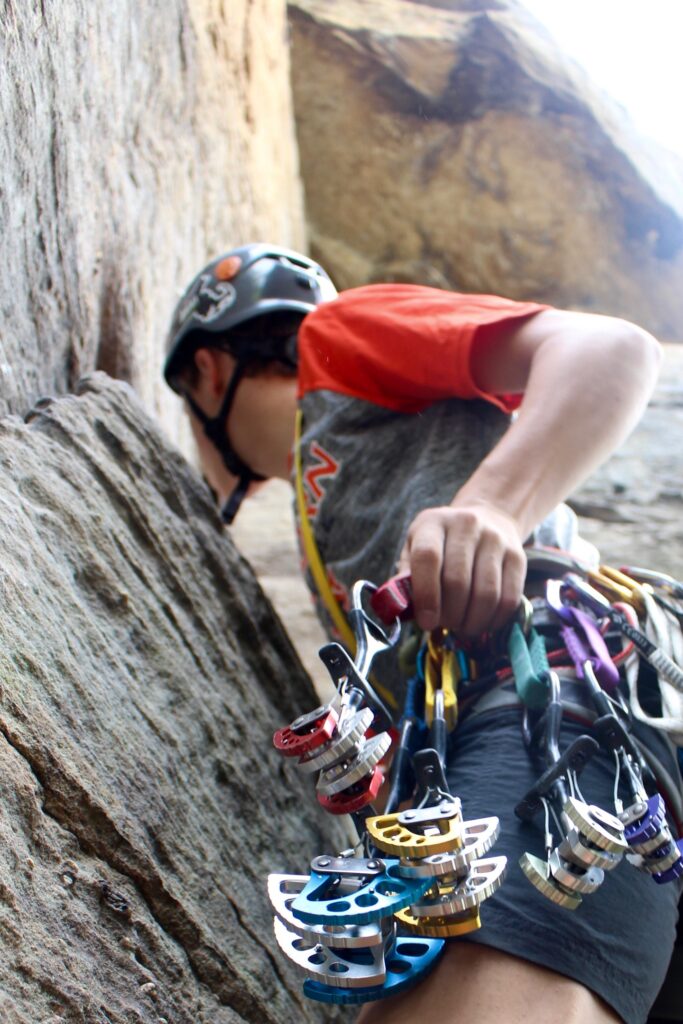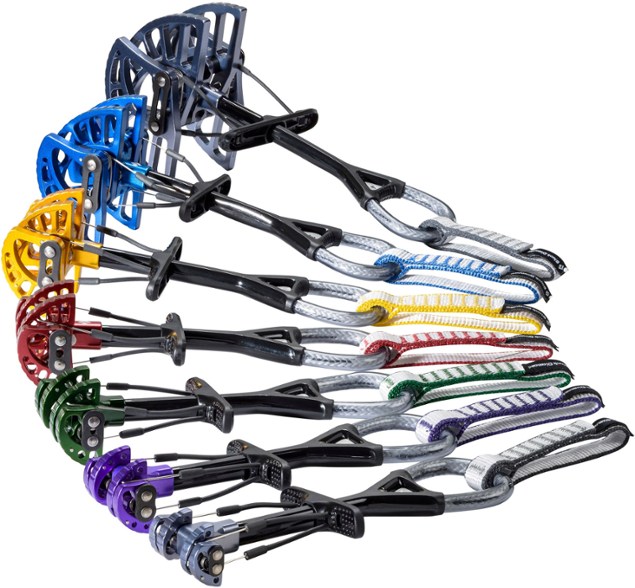
Photo courtesy Billy Simek
The “Standard Rack”
As climbing guide in Red River Gorge, I often get asked “What is the best trad rack for climbing the area.” You’ll frequently hear that a particular route requires a “standard rack”, but no one one ever defines what a standard rack is. Guidebooks and climbers are reluctant to define a standard rack is because, well.. it is subjective. It depends greatly on the comfort level of the climber on the terrain, and how much gear will use to safely protect the route. Add to that, the fact that each climb is unique and will take a variety of gear and sizes to protect it.
Disclaimer: Purchasing a Trad Rack is only the first step, one has to then learn how to use it! Seek a qualified mentor or Climbing School to help you along the way.
RRG Cracks Are Full of Variety
The Red River Gorge is rarely ever “splitter” a term used to describe parallel sided cracks. Splitters stay a consistent size for the duration of the climb. The cracks here in Red River Gorge are filled with variation both from top to bottom, as well as in depth. While a climb may take a #2 Black Diamond Camalot near the surface, further back in the crack may reveal a #1 Camalot placement. This is great news, because you can get away with a smaller rack than those splitter areas like Moab, Utah.
So here it is, my recommendation for a beginner climbing rack in Red River Gorge. This is a starting point, and one could certainly get away with less or require more depending on the climb. I find the following rack gets me up most of the moderate trad climbs in the Red River Gorge. You’ll quickly find based on your style, and the climbs you frequent, which gear you wish you had more of. A trad rack isn’t a one time purchase but something you’ll add to as needed over time.
 Stoppers
Stoppers
A single set of stoppers or “nuts”, (named after the machine nuts climbers slung with cord used before manufactured stoppers were available), is usually sufficient in RRG. The cracks and fissures in Red River Gorge’s Corbin Sandstone are often parallel sided. Making cams the better choice than stoppers in many instances. Having said that, an experienced eye can still find plenty of constrictions for good stopper placements. Stoppers are a little more nuanced to get a solid placement than cams. However, with practice, they offer a reliable and cost effective alternative to similarly sized cams. In fact, stoppers test out stronger in good placements than equally sized cams.
We love the DMM Offset Stopper Set, but a standard set of Black Diamonds Stoppers from #4-13 work great too.
 Cams
Cams
Cams. The bread and butter of every RRG Trad Climbers Rack. A number of companies make really high quality cams. For Bigger Sizes (BD .5 and higher) we love the CLASSIC Black Diamond C4 Camalots. Close runner ups, include the new Wild Country Friends and the DMM Dragon Cams. For smaller cams there are many more options, are current favorites are the Black Diamond Z4 Camalots and the Metolius Ultralight Mastercams. The brands listed our are favorites, but many companies offer quality cams these days. Look for the UIAA rating to make sure your climbing gear has gone through the proper testing. Be wary of non-certified brands that pop up through Amazon and Ebay.
Hexes
A long lasting debate exist, once popular, hexes have mostly been replaced by cams by today’s generation of climbers. You won’t find hexes being racked on many climber’s harnesses in Red River Gorge. They take a lot more time to place, and don’t work as well in parallel sided cracks as cams do. Old school climbers like Legendary Red River Gorge First Ascensionist Larry Day still swear by them. He touts them as a cheaper and lighter alternative to cams, these points are still valid, but as cams get lighter and lighter, the appeal of hexes is fading for use on hard technical climbing.
You could spruce up your rack on a budget with a set of hexes, and they are great for certain applications, like building a bail anchor to leave behind in the alpine, or lightweight pro on easy mountain routes. The bottom line is, we think you’ll find as you progress in your climbing, hexes will get left in the closet, and you’ll wish you would have spent the money on a couple extra cams.
Final Thoughts
The climbing rack is an expensive and daunting purchase, fortunately it’s one that will last you a long time. Don’t feel obligated to but your entire rack all at once, I personally pieced together my current rack over several years. I figured out what brands I liked, and the sizes and types of protection I desired more of along the way. A great way to ease the burden is to find a climbing partner with similar interests. Both parties can buy a single rack and share the rack between one another.
